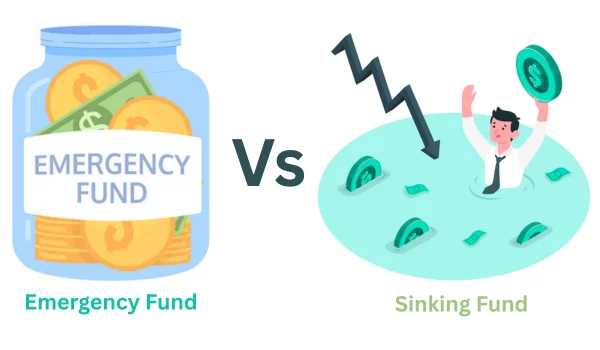In today’s uncertain financial environment, effective savings strategies are essential for both individuals and businesses. Two foundational tools stand front and center: emergency funds and sinking funds—each serving distinct purposes and working together to secure financial peace of mind.
In this article, we’ll explore:
- Definitions & distinctions between sinking and emergency funds
- Why each is important
- How to set them up
- How they complement one another
- Best practices and pitfalls to avoid
Plus, we’ll align our insights with thought leadership from Business Column and reference a useful comparison guide at Businesses Column.
What Is a Sinking Fund?
Definition:
A sinking fund is a planned savings vehicle. You allocate a specific amount of money over time, earmarked for a known upcoming expense. Whether it’s a scheduled business license renewal, software upgrade, equipment replacement, or capital investment, sinking funds spread the financial load and help avoid financial strain.
How It Works:
- Identify a future cost (e.g., ₹200,000 for a new machine in 12 months).
- Divide the total by the timeline (₹200,000 ÷ 12 ≈ ₹16,666/month).
- Save that amount regularly, often into a dedicated savings or high-yield account.
Purpose & Benefits:
- Prevents borrowing or debt: You save upfront, avoiding high-interest loans or credit.
- Accrues without panic: Fees or breakdowns no longer create budget shocks.
- Improves cashflow management: Predictable savings mirror proper business planning.
- Attracts investors: Corporations using sinking funds for debt reduction or bond repurchases bolster creditworthiness.
Types of Sinking Funds:
- Business-oriented: Equipment replacement, annual subscriptions, bond repayments.
- Personal finance: Vacations, weddings, car maintenance.
What Is an Emergency Fund?
Definition:
An emergency fund is a contingency safety net for unplanned, urgent expenses—such as medical emergencies, job loss, or surprise repairs.
Features:
- Unpredictable: You don’t know when or what the emergency will be.
- Flexible: Not tied to a specific purpose—you dip in only for genuine emergencies.
- Size guideline: Generally recommended at 3–6 months of living or operating costs.
Role & Relevance:
- Emergency cushioning: Covers urgent needs like car breakdowns or sudden repair bills.
- Prevents borrowing: Reduces reliance on credit or high-interest loans during crises.
- Ensures continuity: Helps businesses weather downturns or operational snags without cashflow collapse.
Key Differences at a Glance

| Aspect | Sinking Fund | Emergency Fund |
|---|---|---|
| Purpose | Known, planned future expense | Unexpected, urgent expense |
| Usage | Only for its specific goal | Only for true emergencies |
| Timeline | Defined (e.g., save for 6–12 months) | Open-ended (maintain minimum 3–6 months) |
| Organization | Multiple, purpose-specific accounts | One (or few) catch‑all emergency accounts |
| Psychology | Reduces guilt and financial stress | Provides security and resilience |
Why Both Funds Are Essential
Sequential Priority
Step 1: Build Emergency Fund
- The foundation. You can’t plan for emergencies, so this must come first. Many financial experts—including those quoted in Business Column and at BusinessesColumn.com—advise 3–6 months’ reserves before tackling other savings goals.
Step 2: Build Sinking Funds
- Once your emergency fund is solid, you can allocate savings to foreseeable costs and strategic goals.
Complementary Use
- Emergency fund handles surprises (e.g., ₹50,000 emergency surgery or generator repair).
- Sinking fund handles planned events (e.g., the ₹200,000 equipment upgrade due in a year).
Together, they protect liquidity and avert credit fallback.
How to Set Them Up
Step 1: Determine Your Emergency Fund Target
- Calculate 3–6 months of essential operating expenses:
- Wages, rent, utilities
- Debt interest/repayments
- Key variable costs
- Example: ₹200,000/month × 4 = ₹800,000 target.
Where to keep it:
A liquid, low‑risk account (e.g., high‑yield savings), separated from day-to-day cash.
Step 2: Automate Recurring Deposits
- Set automated monthly transfers:
- ₹30,000/month → Emergency Fund → reach ₹800,000 over ~27 months.
- Once full, reassign that ₹30,000 to sinking funds.
Step 3: Create Multiple Sinking Funds
List planned expenditures:
| Goal | Timeline | Total Cost (₹) | Monthly Allocation |
|---|---|---|---|
| Software license renewal | 12 months | 120,000 | 10,000 |
| New office laptops | 6 months | 300,000 | 50,000 |
| Annual compliance audit | 4 months | 80,000 | 20,000 |
Open separate savings accounts or sub‑ledgers for each goal. This approach eliminates fund confusion and eases tracking.
Step 4: Monitor and Adjust
- Review quarterly for timeline or cost changes.
- Keep sinking funds accessible but not intermixed with daily operations.
- If an emergency dips into a sinking fund, plan how to replenish it.
Common Pitfalls & Remedies
- Commingling Funds: Blurs boundaries and may leave you underfunded.
→ Use distinct accounts for each fund. - Premature Spending: Dipping into emergency funds for non‑emergencies.
→ Enforce withdrawal rules; consider penalties for misuses. - Underfunding the Emergency Fund: Thinking it’s “enough” before real coverage.
→ Stay above the 3‑6 months guideline. - Skipping Regular Reviews: Costs/timelines change.
→ Quarterly audits are essential.
Business Column’s Take
An insightful article on Business Column, titled Sinking Fund vs Emergency Fund, thoughtfully illustrates this comparison:
“A sinking fund is designed for planned expenses … whereas an emergency fund provides financial buffering from life’s unexpected shocks.”
They highlight that a sinking fund is for the planned known, while the emergency fund braces you against the unknown—a distinction clear across every prominent financial resource, including Experian and Paylocity.
Deep Dive: Case Studies
A. Small Business Tech Start‑Up
- Scenario: Monthly burn of ₹500,000 with ₹2.5 million in the emergency fund (5 months coverage).
- Sinking funds in place: office rent deposit, laptop refresh cycle, annual audit fees.
- Outcome: When their server failed, they used ₹150,000 from their emergency fund—no revenue interruption or loan.
B. Individual Entrepreneur
- Scenario: Freelance designer, ₹100,000/month living expenses.
– Emergency Fund: ₹500,000 (5 months)
– Sinking Funds: ₹240,000 for a camera in 8 months → ₹30,000/month - Result: Purchases made without diving into general savings—they paid cash upfront.
Optimal Setup Strategy
- Primary Account: Use a high-yield savings account for the emergency fund.
- Sub-Accounts or Buckets: Use services like YNAB or digital banks to create labeled sinking funds.
- Automate Transfers: Use standing instructions to send distinct sums to each fund monthly.
Forecasting the Future
With good cashflow discipline and proper planning:
- Emergency fund becomes a protective firewall.
- Sinking funds enable strategic growth—upgrading tools, scaling operations, managing cyclical costs without financing.
Bonus Tip: Consider placing longer-term sinking funds in liquid zero-fee deposit instruments or short-term mutual funds earning modest yields—while keeping short-term goals in instant-access accounts.
Useful Tools & Calculators
- Sinking Fund Calculator: Divide total cost by months remaining.
- Budget Tracking Software: YNAB, QuickBooks, Mint for separate fund tracking.
- Yield‑Optimized Savings Account: Ensure accounts are interest-bearing and fee-free.
Final Words
Sinking funds and emergency funds are complementary, not rivals. Viewed through the lenses of Strategic Planning and Safety Net, they are essential:
🔹 Emergency Fund protects against randomness and business shocks.
🔹 Sinking Funds enable goal-based savings and proactive organizational control.
A dual‑fund approach:
- Build your emergency fund first
- Then layer in sinking funds for planned investments
- Automate contributions
- Review and rebalance quarterly
By following this approach—advocated by experts and tracked by tools—you build financial resilience and agility. To deepen your understanding, visit Business Column’s breakdown: Sinking Fund vs Emergency Fund.
✅ Summary
- Emergency Fund: 3–6 months of costs; for unplanned emergencies
- Sinking Funds: Goal-specific; for planned future expenses
- Together: Provide complete coverage—adaptable, sustainable, debt-avoidant

